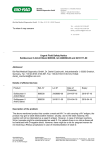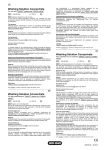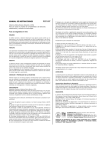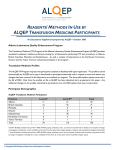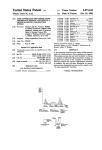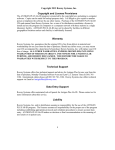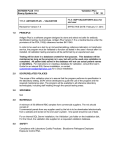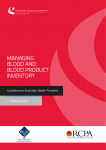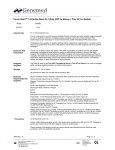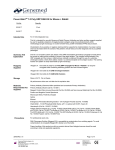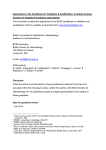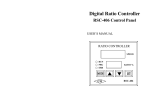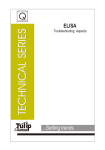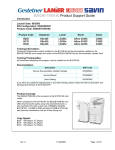Download Reagent Red Blood Cells
Transcript
[US] Reagent Red Blood Cells Biotestcell®-I 8 Biotestcell®-I 11 Biotestcell®-I 11 Plus 3.0 to 3.4% FOR USE IN IDENTIFICATION OF UNEXPECTED ANTIBODIES WITH TANGO® OPTIMO AND BY TUBE TEST* *Tube test is not approved by Health Canada FOR IN VITRO DIAGNOSTIC USE NO U.S. STANDARD OF POTENCY U.S. License Number: 1845 Package size ® [REF] 816020100 [VOL] 8 x 4 mL Biotestcell -I 8 ® [REF] 816021100 [VOL] 11 x 4 mL Biotestcell -I 11 ® [REF] 816022100 [VOL] 11 x 4 mL Biotestcell -I 11 Plus THAT PRODUCTS DERIVED FROM HUMAN BLOOD WILL NOT TRANSMIT INFECTIOUS AGENTS. • Caution: This Product Contains Natural Rubber Latex Which May Cause Allergic Reactions. • Do not use beyond seven days when loaded on the TANGO® optimo. • Do not use samples collected with gel separators of any kind. Specimen Collection Tube Test and Automated Method Fresh samples of clotted or EDTA anticoagulated whole blood collected following general blood sampling guidelines are acceptable. The specimen should be tested as soon as possible after collection. If testing is delayed, ◄ specimens should be stored at 2 to 8°C or the plasma or serum can be separated from the red blood cell and frozen. Stored samples should be allowed to reach room temperature prior to testing. Blood specimens exhibiting gross hemolysis or contamination should not be used. Do not use specimens collected with gel separators. A distinct separation between plasma and red blood cells must be visible for testing. Samples may be centrifuged or allowed to settle. Clotted and EDTA samples older than ten days for tube methods and older than seven days for automated methods may be tested, however antibody reactivity has been shown to decrease in older samples. ◄ Materials Material provided ® ® ® • Biotestcell -I 8, Biotestcell -I 11 or Biotestcell -I 11 Plus Intended Use ® ® ® Biotestcell -I 8, Biotestcell -I 11 and Biotestcell -I 11 Plus are used for the identification of unexpected antibodies which have been found in an antibody screening test using Reagent Red Blood Cells such as Biotestcell® 1 & 2, ® ® ® ® Biotestcell 3 and/or Biotestcell Pool. Biotestcell -I 8, Biotestcell -I 11 and ® Biotestcell -I 11 Plus are used in tube test and solid phase test Solidscreen II with the TANGO® optimo and are suited for all routine testing. For Biotestcell®-I 8 and Biotestcell®-I 11 and Biotestcell®-I 11 Plus the tube test is not approved by Health Canada. ◄ Summary Antibody identification is used to determine specificity and possible clinical significance of antibodies against red blood cell antigens detected in the method used for detection of unexpected antibodies. This determination is important for the selection of products for transfusion as well as for pre-natal care. ® ® Bio-Rad Reagent Red Blood Cells Biotestcell -I 8, Biotestcell -I 11 and Biotestcell®-I 11 Plus are used to determine the specificity of an antibody detected by the previous antibody screening or crossmatch. Routine pretransfusion studies always include tests for the antibody identification of detected antibodies to red blood cells. Material required but not provided A. 3-phase-tube test • Pipettes ◄ • Isotonic saline • Anti-Human Globulin Anti-IgG (e.g. Bio-Rad [REF] 804175100) • Anti-Human Globulin Anti-IgG, -C3d; Polyspecific (e.g. Bio-Rad [REF] 804115100) • IgG coated red blood cells (e.g. Bio-Rad Coombscell-E [REF] 816030100) • Potentiators(e.g. MLB 2 Bio-Rad Modified LISS [REF] 805200100 50 mL glass bottle or MLB 2 Bio-Rad Modified LISS [REF] 805205100 10 x 10 mL glass bottle (not to be used with TANGO® optimo) or albumin (optional). The 10 mL MLB 2 glass bottle are not approved for tube testing by Health Canada). • Glass tubes 10 x 75mm or 12 x 75mm • Serological centrifuge • Interval timer • Markers • Agglutination viewer (optional). ◄ Principle of the Test Antigens of the Reagent Red Blood Cells react with the corresponding antibodies in the serum or plasma directly or after addition of Anti-Human Globulin. In a tube test agglutination will occur. In solid phase test Solidscreen II a uniform layer of red blood cells on the micro test plate wells will occur. Material required but not provided B. TANGO® optimo • TANGO® optimo Bio-Rad [REF] 848900010 • Solidscreen II Bio-Rad [REF] 806521100 • Anti-Human Globulin, Anti-IgG Solidscreen II [REF] 806516100 • Bio-Rad MLB2 (Modified LISS Bio-Rad) [REF] 805200100 • Solidscreen II Control [REF] 806514100 • Solidscreen II Control B [REF] 806519100 • Solidscreen II Negative Control [REF] 806509100 • Alsevers Solution [REF] 806510100 • Cell mixers Reagent ® ® ® Biotestcell -I 8, Biotestcell -I 11 and Biotestcell -I 11 Plus are Reagent Red Blood Cells with polyvalent antigens. Biotestcell®-I 8 and Biotestcell®-I 11 contain the following antigens: D, C, Cw, E, c, a b a b a b b a b a a e, K, k, Fy , Fy , Lu , Lu , Jk , Jk , Js , M, N, S, s, Le , Le , P1, Xg , Co . Biotestcell®-I 11 contains the additional antigens: Jsa, Dia, and Kpa. Biotestcell®I 11 Plus contains the following antigens: D, C, E, c, e, K, k, Fya, Fyb, Lub, Jka, b b a b a a w a a a Jk , Js , M, N, S, s, Le , Le , P1, Xg , Co and if available C , Lu , Js , Di and Kpa. For the antigen content of each production lot, please refer to the enclosed ® ® ® table. Biotestcell -I 8, Biotestcell -I 11 and Biotestcell -I 11 Plus are also suited for use with enzymes (papain, ficin, bromelin, trypsin) or enhancement reagents (e.g. albumin, LISS). The life span of enzyme treated Reagent Red Blood Cells is listed in the instructions for use of the respective enzymes. Biotestcell®-I 8, Biotestcell®-I 11 and Biotestcell®-I 11 Plus are suspended 3.0 to 3.4% in a modified Alsevers solution and can be used immediately after careful resuspension. Biotestcell®-I 8, Biotestcell®-I 11 and Biotestcell®-I 11 Plus are produced every 4 weeks. Preservative: 0.01% Neomycin, 0.033% Chloramphenicol, 5 ppm Amphotericin B Precautions • For in vitro diagnostic use. • Store at 2 to 8°C. • Do not use beyond the expiration date. • Do not use damaged vials. • Do not use if markedly hemolyzed or discolored. • Handle and dispose of reagents as potentially infectious. • Caution: Do not pipette by mouth. The absence of all viruses has not been determined. • Caution: ALL BLOOD PRODUCTS SHOULD BE TREATED AS POTENTIALLY INFECTIOUS. SOURCE MATERIAL FROM WHICH THIS PRODUCT WAS DERIVED WAS FOUND NEGATIVE WHEN TESTED WITH FDA LICENSED EIA/ELISA TESTS. NAT TESTING WAS NOT PERFORMED. NO KNOWN TEST METHOD CAN OFFER ASSURANCE Test Procedure Resuspend Reagent Red Blood Cells prior to use and allow to reach room temperature. The procedures below are intended as guidelines. It may be desirable to modify these procedures based on in-house requirements or standard operating procedures. ® ® The 3-phase-test (tube technique) with Biotestcell -I 8, Biotestcell -I 11 and ® Biotestcell -I 11 Plus has not been approved by Health Canada for use on the Canadian market. A. 3-phase-tube-test If an enzyme or enhancement reagents (albumin, LISS) is used, please refer to the respective instructions for use. If an autocontrol was not performed with antibody detection testing, it should be performed with antibody identification testing. Phase 1: Immediate Spin 1. Place two drops (approx. 40 to 50 µL each) of serum/plasma to be tested into each tube labelled for a selected red blood cell. ® 2. Add 1 drop of corresponding Biotestcell Reagent Red Blood Cell suspension to the appropriate tube and mix. 3. Centrifuge for: a. 20 seconds at 800 to 1000 x g or b. at a time and speed appropriate for the centrifuge calibration. 4. Gently dislodge the red blood cell button and observe for macroscopic agglutination or hemolysis. Negative reactions may be examined with an agglutination viewer, however, microscopic examination is not recommended. 5. Record results. Often the immediate centrifugation test shows expression of anti-M, -N, -P and cold reactive antibodies. Phase 2: Incubation Refer to instructions for the enhancement reagent being used. 6. Incubate at 36 to 38°C for 30 to 60 minutes or as appropriate to the enhancement reagent used. 7. Centrifuge for: a. 20 seconds at 800 to 1000 x g or, b. at a time and speed appropriate for the centrifuge calibration. 8. Gently dislodge the red blood cell button and observe for macroscopic agglutination. or hemolysis. Negative reactions may be examined with an agglutination viewer, however, microscopic examination is not recommended. 9. Record results. With the centrifugation test after incubation mainly Rh-antibodies as well as some incomplete antibodies are detected. Phase 3: Indirect Antiglobulin-Test (IAT) 10. Wash the red blood cells 3 times with isotonic saline. Decant supernatant saline completely. 11. Follow the directions of the Anti-Human Globulin manufacturer. 12. Centrifuge for: a. 20 seconds at 800 to 1000 x g or b. .at a time and speed appropriate for the centrifuge calibration 13. Gently dislodge the red blood cell button and observe for macroscopic agglutination. Negative reactions may be examined with an agglutination viewer, however, microscopic examination is not recommended 14. Record results. 15. To control all negative antiglobulin tests, add red blood cells sensitized with IgG antibody, e.g. Coombscell E (see package insert for procedure). This test shows IgG antibodies such as anti-Duffy, anti-Kidd, all Rh-antibodies. B. Solidscreen® II and TANGO® optimo Detailed test procedure instructions as well as details for the evaluation of test ® results are given in the instructions for use of Solidscreen II and TANGO optimo, User’s Guide. Stability of the Reaction Tube Test Following centrifugation, all tube tests should be read immediately and results interpreted without delay. Time delays may cause a dissociation of the antigenantibody complexes resulting to false negative or more often weak positive reactions. ◄ Quality Control For quality assurance the Biotestcell Reagent Red Blood Cells intended for antibody identification should be tested according to any site specific procedures. ◄ Interpretation of QC The tests are considered valid if the expected results for the controls are obtained. If the controls do not give the expected results, you must determine the cause for the failed QC. Follow institutional SOP for repeat testing of QC samples, repeat testing of patient/donor samples and documentation of QC results and corrective action if required. Please contact Bio-Rad Laboratories, Inc., (800-224-6723) if controls repeatedly fail to give expected results. Interpretation of Results Tube Test Agglutination of the red blood cells is a positive result and indicates the presence of an unexpected antibody(ies). No agglutination is a negative result and indicates that no unexpected antibody was detected. An agglutination viewer may facilitate the reading of tube tests (as recommended by the AABB Technical Manual, ◄)1. The positive and negative reactions are compared to the Biotestcell®-I 8,-I 11 and -I 11 Plus antigen pattern and are read accordingly. For verification an additional antigen test of the red blood cells may be performed. M Bio-Rad Medical Diagnostics GmbH Industriestr. 1, D-63303 Dreieich, Germany www.bio-rad.com, [email protected] Tel.: +49-6103-3130-0 , Fax: +49-6103-3130-724 ® TANGO optimo ® Refer to the TANGO optimo User’s Manual for detailed instructions on the interpretation of reactions. ◄ Limitations • Negative reactions and subsequent positive reactions with IgG coated red blood cells indicate that the serum contains no detectable antibodies against one of the antigens present on the Reagent Red Blood Cells (enclosed antigen pattern). • Because some antibodies show dosage effect, the antigen density on the Reagent Red Blood Cells needs to be considered when evaluating the test results (homozygous or heterozygous hereditary disposition). A heterozygous expression of the antigen may result in non-detection of weak antibodies depending on the used test method. • In very rare cases HLA-antigens within the product may lead to false positive reactions. • The reactivity of the product may decrease during the dating period and therefore should not be used after the expiration date. The rate of decrease in reactivity is partially dependant on individual donor characteristics that are neither controlled nor predicted by the manufacturer. • Negative reactions will be obtained if the sample contains antibodies present in concentrations too low to be detected by the test method employed. No test method is capable of detecting all red cell antibodies. ® ® • The 3-phase-test (tube technique) with Biotestcell -I 8, Biotestcell -I 11 and Biotestcell®-I 11 Plus has not been approved by Health Canada for use on the Canadian market. Specific Performance Characteristics Testing is performed in accordance with FDA recommended methods. The final release testing is performed according to the product specific SOPs. As part of the release process each lot of Bio-Rad Reagent Red Blood Cells is tested according to the package insert method against a panel of blood grouping reagents to insure suitable reactivity. To exclude a mix-up of the Reagent Red Blood Cells with identical Rh phenotype at least one differential antigen has to be tested. The result must react appropriately positive or negative. NO U.S. STANDARD OF POTENCY. For the product performance it is necessary to adhere to the recommended method in the instructions for use. For Technical Support or further product information, contact Bio-Rad Laboratories, Inc., at 800-224-6723. Note ◄ Manual techniques are to be performed according to the manufacturer’s instructions. Each deviation from these instructions is the sole responsibility of the user. Used test material must be discarded as hazardous material. Manage waste according to local, state and national regulations. Glossary of Symbols Symbol Definition Symbol Definition [LOT] Batch Code [IVD] In vitro diagnostic medical device ! Caution, consult accompanying documents I Consult instructions for use. M Manufacturer e Use by YYYY-MM-DD s Contains sufficient quantity for <n> tests. [REF] Catalog number t Temperature limitation [VOL] Volume Bibliography 1. John D. Roback, MD et al. Technical Manual 17th Edition, Bethesda, MA: AABB, 2011. Key: Underline = Addition of changes ◄ = Deletion of text 186186/16 Rev. 08/2014



